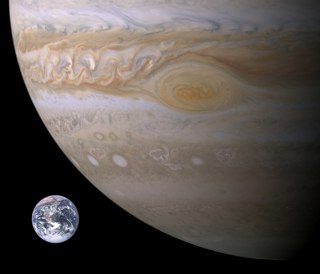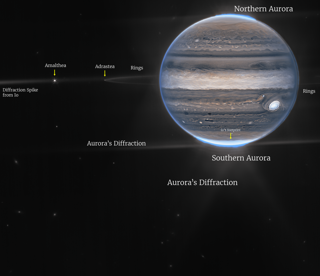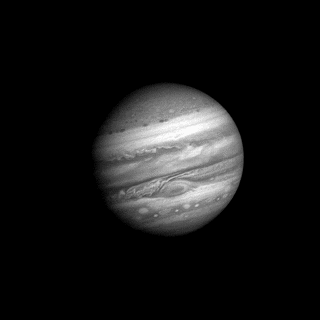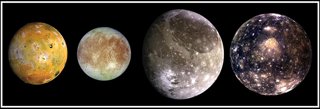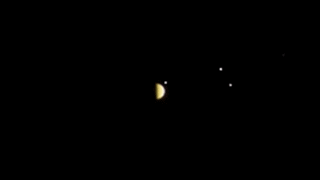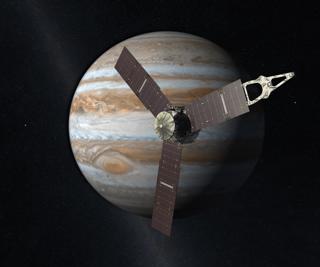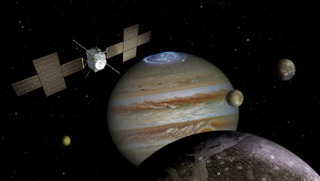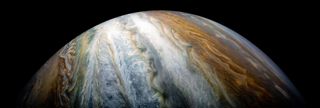
The Planets: Jupiter
- 26th Sep 2022
- Author: Ed Kellond-Turner
Jupiter is the fifth planet from the Sun and the largest planet in the Solar System. It is so large that all the other planets could fit inside it with room to spare.
Left over gas and dust from the formation of the Sun came together to form this humungous planet around 4.5 billion years ago, and Jupiter settled into its current orbit about 4 billion years ago.
The surface of Jupiter has many interesting features, including the Great Red Spot; the largest storm in the Solar System, which has been raging for at least 350 years with wind speeds of up to 268 miles per hour. The planet’s stripes and swirls are cold/windy ammonia and water clouds, floating in a hydrogen and helium rich atmosphere.
The coloured bands on Jupiter are formed by rising and falling gas. The lighter bands, known as zones, are formed by rising gas, and the darker bands, known as belts, are formed by sinking gas. The colour variation is caused by differing temperatures and composition of the gases that make up the planet.
Planet Factfile
Size: Jupiter is almost 140,000 km across, making it around eleven times larger than Earth, and the largest planet in our Solar System.
Gravity: Though much more massive, Jupiter is much less dense than Earth, making the gravity only two and a half times stronger at the surface than on our planet.
Age: Jupiter was the first planet to form in the early stages of the Solar System around 4.5 billion years ago.
Distance: On average Jupiter orbits 778 million kilometres from the Sun which means it takes around twelve years to complete one orbit. Astronomers might also say Jupiter lies at a distance of 5.2 AU (Astronomical Units) meaning it lies roughly five times further from our star than the Earth does.
Composition/Structure: Jupiter is mostly comprised of hydrogen and helium and is known as a gas planet. But deeper in the atmosphere this gas gets compressed into a liquid and even deeper down the pressure increases and electrons around hydrogen atoms are stripped off turning it into an electrically conducting liquid. As Jupiter spins, it produces electrical currents in this region producing Jupiter’s immense magnetic field. What’s still unclear if Jupiter has a solid central core or if it remains a thick, super-hot, dense soup.
Atmosphere: Jupiter has a hydrogen (90%) and helium (10%) rich atmosphere with trace amounts of other gases. The planet likely has three cloud layers – the top likely made of ammonia ice, the middle probably consisting of ammonium hydrosulphide crystals and the innermost layer comprising of water ice and vapour.
Temperature: the average surface temperature of Jupiter is -110 degrees Celsius. Closer to the core of Jupiter the pressure increases and so does the temperature – at the centre it’s thought to be a scorching 20,000 degrees Celsius.
Rotation: One Jovian day lasts just less than ten hours, the fastest day of any planet!
Speed: taking roughly twelve years to complete one orbits, Jupiter travels around our star at a speed of 13.07 kilometres per second – roughly half the speed that Earth travels at.
Moons: Jupiter has 79 moons – while over 50 of them have names, the others are still awaiting official titles! There could be even more though that we haven’t yet discovered.
Auroras: Formed from not only charged particles from the Sun, but also particles thrown into space by its moon Io – Jupiter has aurora hundreds of times more energetic than Earth’s.
Rings: It’s not just Saturn that has rings. Jupiter also has a faint ring system mostly made of dark dust!
Discovered by: Ancient humans! As one of the brightest naked eye planets, Jupiter has been observed, worshipped, and studied since we began looking up at the skies above us, but there’s still so much more we have to discover about it.
The Moons of Jupiter
Some of the most interesting moons around Jupiter are the four Galilean moons: Io, Europa, Ganymede, and Callisto. Recognised as the first moons (other than our own) in March 1610, they are the only moons of Jupiter that have a spherical shape.
Io has the closest orbit to Jupiter of the Galilean moons, and is the most geologically active object in the Solar System with over 400 active volcanoes. The surface of Io is primarily made up of silicate rock, and its very thin atmosphere is comprised mostly of sulphur dioxide.
Europa is the smallest Galilean moon. The surface of the moon is ice, and it is suggested under this icy layer could be a liquid water ocean which could harbour alien life, though this is unproven. Tidal forces from Jupiter’s massive gravitational influence would keep this ocean liquid and drive geological activity alike to thermal vents on the Earth’s ocean floor.
Ganymede is the largest moon in the Solar System, larger even than Mercury, though with less mass. Ganymede likely has a liquid iron core, enabling it to sustain a magnetic field – the only satellite in the Solar System to do so. Ganymede has a thin atmosphere comprised of oxygen, ozone, and some atomic hydrogen.
Callisto is the least dense of the Galilean moons and one of the most heavily cratered bodies in the Solar System, including a 3000 kilometre wide crater known as Valhalla. Callisto likely has a liquid water subsurface ocean, though the presence of life on the moon is less likely than its icy neighbour.
Io, Europa and Ganymede are in a 4:2:1 orbital resonance with each other, meaning that in the time Ganymede completes one orbit of Jupiter, Europa complete two and Io zooms around four times.
Missions to Jupiter
Pioneer 10 – 1972 – The first mission to be sent to the outer Solar System, this satellite studied and photographed Jupiter and some of its moons before following an escape trajectory from the Solar System.
Pioneer 11 – 1973 – This satellite used Jupiter’s massive gravitational influence to alter its trajectory towards Saturn.
Voyager 2 – 1977 – The Voyager 2 mission is still ongoing, after visiting all of the outer planets it continues to send back useful data as it leaves the Solar System.
Voyager 1 – 1977 – Although launched after Voyager 2, Voyager 1 made it to Jupiter first, using it as a gravitational slingshot to flyby Saturn and eventually leave the Solar System.
Galileo – 1989 – This first orbiter around Jupiter studied the planet and its Galilean moons over almost 14 years. The satellite also contained a probe which entered the Jovian atmosphere and collected data for almost 58 minutes.
Ulysses – 1990 – Ulysses investigated the Jovian magnetosphere as it flew by the planet, using the planet’s gravity to transfer into a heliospheric orbit over the Sun’s poles.
Cassini – 1997 – Cassini used Jupiter’s massive gravitational influence to fling it towards Saturn. During its flyby it took very detailed images of Jupiter’s atmosphere.
Juno – 2011 – The ongoing Juno mission studies Jupiter from a polar orbit and is projected to continue its mission until 2025.
Jupiter Icy moons Explorer (JUICE) – 2023 – This satellite will make multiple flybys of Ganymede, Callisto, and Europa before going into orbit around Ganymede.
Europa Clipper – due to launch October 2024 – As one of the most probable places for the existence of life in our Solar System, the goal of this mission is to gather data on Europa and its subsurface water.
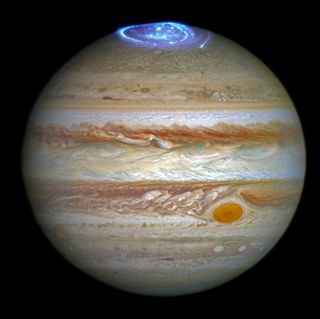
Full image credits / references
(Banner image) The Swirling Clouds of Jupiter as seen by the Juno Spacecraft. Credit: NASA/JPL-Caltech/SwRI/MSSS/Kevin M. Gill
(1)The Size of Jupiter Compared to the Earth. Credit: NASA
(2a) James Webb Space Telescope Captures Jupiter in Infrared. Credit: NASA, ESA, CSA, Jupiter ERS Team; image processing by Ricardo Hueso (UPV/EHU) and Judy Schmidt
(2b) Jupiter From Voyager 1's Approach. Credit: NASA/JPL
(3a) The Galilean Moons. (L2R) Io, Europa, Ganymede, and Callisto. Credit: NASA/JPL/DLR
(3b) Jupiter and the Galilean Moons Animation. Credit: NASA/JPL/MSSS
(4a) Artist's Impression of the Juno Spacecraft in Orbit Around Jupiter. Credit: NASA/JPL
(4b) Artist's Impression of JUICE Exploring Jupiter and its Icy Moons. Credit: NASA
(5) Hubble Captures Vivid Auroras In Jupiter's Atmosphere. Credit: NASA, ESA, and J. Nichols (University of Leicester)

